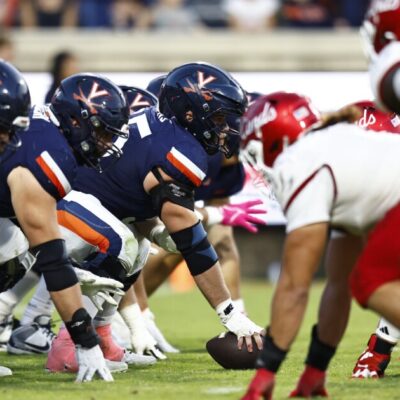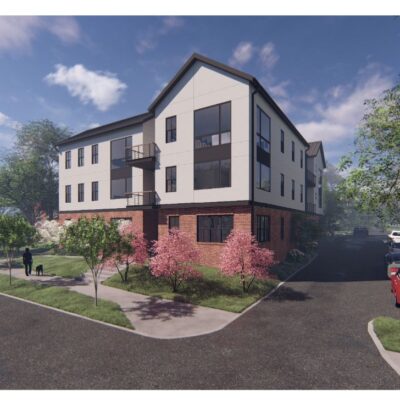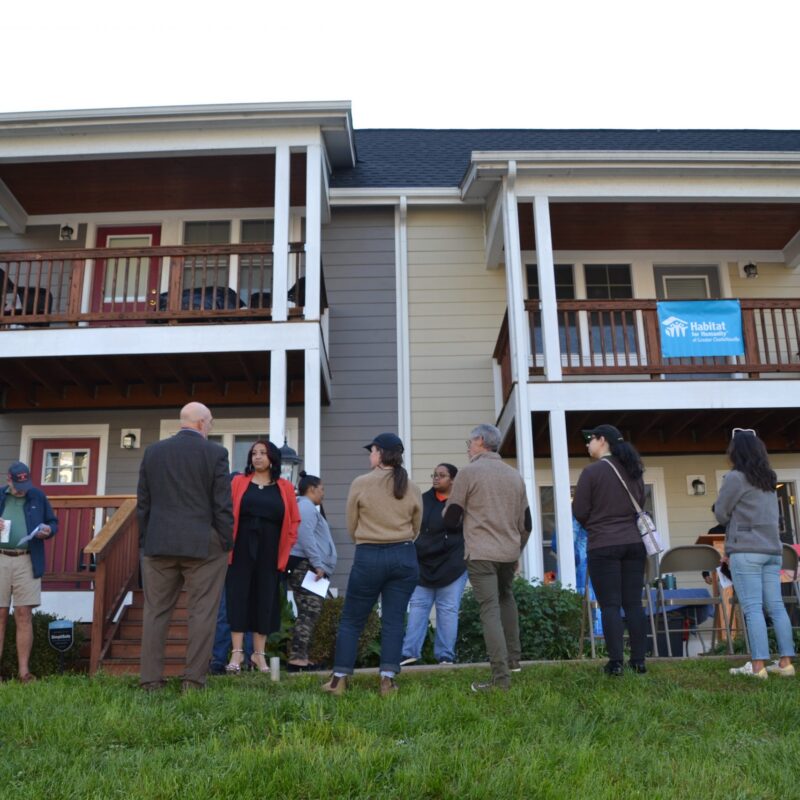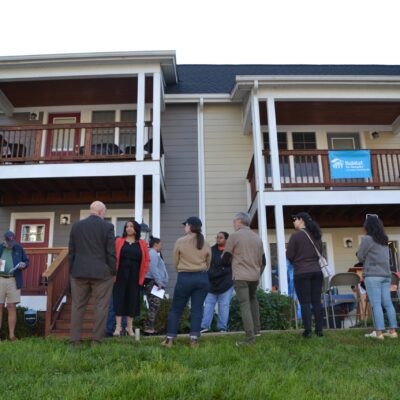Alexis Zeigler* came at age 18, he says, “to get the fuck out of Georgia.” Aubee came to escape the “barrage of ads” that filled her life in San Francisco. Apple came, giving up a job leading Outward Bound trips, to find “a life of investment, the richness of really digging in” to the natural world in which she’d been an adventurer, more than a steward.
Plenty of outsiders come. They’ll pull off I-64 at Shannon Hill, then follow the calm roads a few miles north into Louisa County. Along the way is the usual rural mix of trailers, tiny frame houses, more prosperous-looking farms. Women drag push-mowers over their yards; mailboxes are broadly spaced, each marking the end of a driveway. The landscape here is an illustration of the idea that each family has its own space, makes its own way and looks after its own affairs.
At the end of the trip lives another idea.
Members of Twin Oaks say it’s now the nation’s oldest and largest secular—what? Commune? Intentional community? Income-sharing collective? The terms can be unpleasantly loaded. One ex-member heard it described as “a combination college experience, summer camp and monastery,” and calls the description apt. It’s a rare survivor of the era when hippies founded communes all over the country. On its 40th anniversary this June 16, Twin Oaks will reach a milestone that the vast majority of those communes never approached.
Dropping out, joining in
Plenty of outsiders come, because Twin Oaks is energetic about inviting them. The community has a detailed system for recruiting new members: If you want to join, you have to spend three weeks here first, during which you might milk cows, weave hammocks and cook breakfast in the dining hall. Then you have to leave and wait 10 days to see whether the community will invite you to join; after that you have to think about it for yet another month before making a decision.
The process is meant to both avoid disruptions to the community (visitors are shepherded by designated handlers) and, as far as possible, to keep people from joining hastily. After all, the choice is a sweeping one: to freeze one’s assets, move to rural Louisa County, and plug into a distinctive subculture where everyone goes by a single name—often not their birth name—and Valentine’s Day is replaced with another holiday, called Validation Day.
| Twin Oaks on paper
Year founded: 1967 Current members: 106 Current number of kids: 12 Yearly turnover: 18-25 Number of acres: 450 Number of residences: 8 Number of bikes: around 45 Number of cars: 17 Number of original 8 founders still living there: 0 Weekly work quota: 42 hours Monthly spending allowance per member: $76 Average yearly vacation time per member: 8 weeks |
The visitors come for many reasons. A common refrain is that they’d stumbled on some mention of Twin Oaks and been surprised: Communes still exist? Derek Breen had that reaction in 1991 as a young Navy recruit serving in Desert Storm. “Someone had given me a back issue of the Utne Reader,” he says; there was a little ad in the back for the Federation of Egalitarian Communities, to which Twin Oaks belonged. “If I had known about these I probably wouldn’t be on a battleship in the middle of the Persian Gulf right now,” Breen remembers thinking. The idea of communal living struck a chord, and nine years after the war, (four in college and five in a TV career), he was ready to join.
Everything—the garden, the older buildings in the central courtyard and the newer ones back among the trees, the gravel paths, daffodils, opinions posted on 3" x 5" cards, the wood piles and beards and mismatched furniture and frayed sleeves and bike racks and deep rural quiet—“Everything seemed right,” he says.
The exchange
Ake and I talk on the back deck of Twin Oaks’ big central dining hall, surrounded by woods. He came here last January from Chicago, where he was making up to $50,000 per quarter as a freelance writer of website copy. He’d always had a latent urge toward environmental activism, and through his work he saw firsthand that “marketing is such an amazing tool for affecting social change,” he says; he wanted to use that tool for environmental causes. Moving to Twin Oaks was a way to lower his expenses, to form friendships deeper than the “coffeehouse relationships” he had in the city, and to “make myself an authority” on the way of life he thinks the world needs to hear about. At Twin Oaks, he eats local organic food, is heated by selectively harvested wood, and gets around by foot. And at age 35, he’s now living on about $2 a day.
That figure is small, but misleading. Members exchange their work hours—42 per week—for having the major expenses of life covered: housing, food, health care, clothes, education. Everything is collectively owned: the land, buildings, bicycles, cars. Each member has a private bedroom in one of eight dormitory-style buildings, and otherwise all space is common space. “If it’s possible to share things, we share them,” says Paxus, who earns many of his work credits by recruiting new members.
Decision-making can be cumbersome when the household comprises dozens of people. It’s a way of life in which, “if you want to plant a tree, you have to ask permission; someone is in charge of the courtyard,” Apple says.
Cooperation is an official core value, and members take it up in all kinds of ways. (Ake has been playing cooperative Scrabble once a week with the other members of Tupelo, the residence where he has his bedroom: Instead of competing with each other, they total their scores.) Equally important, though, are the dozens of systems in place to guide members through the many small decisions that keep daily life at Twin Oaks running smoothly. You shouldn’t grab a bike and ride it downhill unless you also brought a bike uphill; otherwise, all the bikes will end up at the bottom. You shouldn’t hoard community-owned clothes in your personal closet. You are flat-out forbidden to own your own car.
In other words, the social contract at Twin Oaks is made explicit, so as to distinguish itself from the hidden contracts of the larger culture. Give up the usual individual pursuit of property and power; get security in return. Give up some privacy; get support and intense socializing.
Keenan, who’s lived here for 24 years, puts it this way: “It’s a very American way of doing things: We tinker with systems.”
Keeping connected
Once new members arrive, they encounter a world full of ironies.
The community aims for partial self-sufficiency. At lunchtime on a recent Wednesday, the steam tables in the dining hall held dilled carrots, kale, salad and potatoes that had all been grown in Twin Oaks’ organic gardens, which stretch toward the dirt road from the central courtyard. One of the day’s cooks approached the line of diners, saying, “Does anyone want this baked potato that we accidentally put the beef sauce on?” “Ugh,” someone replied. Oakers make their own cheese, honey and tofu.
There were also black beans and rice purchased from the institutional food company Cisco. Some of the money to buy those foods comes from the community’s hammocks business. “Twin Oaks hammocks are made with olefin rope, a petroleum product,” says Derek Breen. “You’ve got this hippie commune, this eco-village, making most of their money from a petroleum product and oak, much of which is not necessarily harvested in a sustainable way.”
One irony, then, is that the ability to be self-sufficient and sustainable depends on certain connections to the outside world, where things often stand in sharp contrast to Twin Oaks’ environmentalist ideals. The outside world builds the 17 cars that Oakers are proud of sharing (Paxus points out that, in mainstream America, the average group of 100 people would own 57 cars). The outside world supplies the computers and Internet connections; it pays a good hourly rate for crews of Oakers to put down the basketball floor in the John Paul Jones Arena and pull it up again in time for concerts.
The outside world, with its disposable culture, generates a flow of castoff chairs, toasters and T-shirts that help provide members with what Paxus calls “access to middle-class levels of resources.” “We dumpster-dive at UVA,” says Apple. She’s framed by a big window in a clean, homey living room at Oneida, a women’s residence; two big, healthy-looking potted geraniums flank the couch she sits on, and gauzy white curtains filter the sunlight. Well-worn paperbacks line shelves on the opposite wall. “If this were not a comfortable lifestyle, I wouldn’t do it.”
The outside world also breeds a number of dissatisfied citizens, people fed up with the violence or crime or anonymity of modern life. Some of these find their way to Twin Oaks, which accepts some applicants and rejects others. (By press time, Twin Oaks did not respond to a question seeking specifics.) Through a selective membership process, the community can increase its chances of functioning well.
Another irony: By joining a group of 100, members say, they can be truer to their individual selves. “We’re fairly accepting as a community,” says Aubee. “In some ways—sexual orientation, religion—people are more apt to express themselves.” She herself has felt safe enough, in her two and a half years here, to take women as lovers, which she never did outside.
Alexis puts it more strongly. “In mainstream, you have to be pretty, outgoing, whatever,” he says. “At Twin Oaks you can be nerdy, awkward and still put together a circle of friends. It’s a hugely therapeutic environment.”
Alexis’ way of using the single term “mainstream,” as shorthand for the wider world that Twin Oakers leave behind, is common to many members and ex-members. In their parlance, the opposite of mainstream is another single term, “community.” To be in community—to work, live, raise children and share income with a small, tight-knit group—is, they say, to experience human relationships in a way that most people in mainstream simply do not.
The closeness—the lack of anonymity—is certainly double-edged. Marsha Burger and Jon Kessler lived at Twin Oaks for about 10 years, ending
in 1997. A decade removed from the commune where they met, the two could be mistaken for any ordinary couple in their 40s. We talk in Lee Park on Marsha’s lunch break from her job in a law office. They sound a little wistful when they describe how life outside, with its work and family commitments, makes it harder to keep up friendships. At Twin Oaks, “you have so much time to relate,” says Marsha; work, home and social life are integrated.
Back on the farm, Apple says the blurred boundaries can be hugely challenging. “Living here, you have to compartmentalize,” she says. “Having so many people that I know so well—someone might have some emotional outburst,” and the effects ripple outward through the little village. Later, she and I are headed for lunch in the dining hall and pass a small group eating at a picnic table. “Apple, I need to have a fairly heavy conversation with you today,” one guy calls out. “O.K.,” she replies, a little ruefully.
At the extreme, people’s private demons can create a serious crisis. A woman named Delancey, despite the efforts of a designated care group to help her battle her depression, eventually committed suicide in 1993; Alexis, her close friend, was one of several people who left Twin Oaks soon afterward. “Twin Oaks has struggled with mental illness,” he says—how to treat it, where responsibility lies. Alexis went to Floyd County and co-founded a new community. It was called Abundant Dawn, after Delancey’s birth name.
The engine
A final irony: A way of life that may look, to outsiders, like a form of escape from a capitalistic rat race actually banks its existence on a detailed system that keeps every member working hard and community income flowing.
I asked many members and ex-members why Twin Oaks has survived for four decades while other communes failed, and to a person, they answered as Mala did: “The labor system is the secret.” She compares work to the “glue of a common religion or guru” that might keep, say, a monastery or other spiritual community intact. “[The system] makes clear what needs to be done,” she says, from washing dishes to maintaining vehicles to managing the community businesses. Specific numbers of hours are allocated for each task. Mala says this helps reduce what she calls the “slacker/martyr” syndrome, where some members shoulder too much while others coast. (Not everyone agrees that it works: “Ultimately all work wasn’t done and can never be done,” says Derek Breen. “I was working harder than I did in mainstream and it was harder to see what the benefit was.”)
To meet the 42-hour weekly work quota, most people assemble a patchwork of tasks. Apple logs hours in the garden, on the visitor team, with the forestry crew. Ake mostly does desk jobs: marketing for the hammocks business and the community itself. Keenan has done everything over the years from building new residences to researching legal questions, but these days he mostly does child care. An hour at any job counts the same as an hour at any other, whether skilled or unskilled, hands-on or computer-based.
Even more striking: Members get credit for the kinds of work that most people squeeze in around their income-earning jobs—the domestic and personal stuff. Work credits are given for doing laundry, shopping for sundries, voting, and changing diapers. After working 42 hours, members’ time is largely their own.
To raise a child
Mala asks if we can talk while she bathes her one-and-a-half-year-old son, Zadek. He’s blond and rosy-cheeked, in contrast to her dark hair and olive skin. In a big bathroom in her residence, Mala takes off her boots and Zadek’s diaper and helps him into the tub, where he gets interested in two rubber duckies.
Mala gets 18 work credits a week to take care of Zadek; Ezra, his father, gets nine. They spend more time with him than that, though—at least one parent is with him for all but a couple of hours every day. Besides his parents, Zadek gets nine hours of care each week from “primaries”—other members who see him regularly as part of their own work quotas.
We keep talking as Mala towels off her son, then herds him down the hall to the two adjacent bedrooms assigned to their little family. She says she’s been very happy in her more than six years here. “It’s all been very much as I expected,” she says; she did her homework before she joined, taking a whole year to visit intentional communities across the country. She’d studied anthropology and learned that historically, for humans, “it came more naturally to live in tribal groups and be connected,” unlike the “transient suburbs” where she grew up. For at least as long as Zadek is growing up, Mala thinks she will live at Twin Oaks.
The way this tribe cares for Zadek and its 11 other kids has changed, Keenan says, “dramatically.” In the earliest days, when Twin Oaks hewed closer to its origins as a behaviorist community, founded in imitation of B.F. Skinner’s 1948 novel, Walden Two, children had no special relationship with their parents as compared to any other adult. As recently as 1998, a Washington Post article quoted Keenan as saying, “People with families…are systematically discriminated against” in the community’s membership process and in other decisions, like room assignments.
Things have changed. Now, he says, “families tend to stay. It’s seemingly a good place to raise kids.” He and his wife, Kristen, live in the same residence as Mala, Ezra and Zadek—one of four at Twin Oaks that are explicitly child-friendly. Keenan himself spends lots of time with his son and stepson, and he’s writing a how-to book on fathering.
His older boy reads three or four hours a day, and Keenan calls Twin Oaks kids in general “very self-entertaining.” Still, mainstream’s siren song gets through. “They want TV, junk food,” he says. “They love staying in hotels.”
The rotation
In the end, it may be sheer pragmatism and a willingness to adapt that keep Twin Oaks going.
“We don’t have a cult of personality,” says Keenan. None of the original eight founders of Twin Oaks still live on the farm; the one who stayed most involved, Kat Kinkade, moved to her own house in Mineral several years ago. She was, Keenan says, “a capable leader, driven by passion and not by ideology”—she saw the survival of Twin Oaks as paramount, more important than being a vegetarian community or an activist community or any other specific version of paradise.
Debates, disappointments, broken relationships, good intentions—all have come and gone over 40 years. So have hundreds of people. Every year, as much as a quarter of the membership leaves and is replaced, while the community structure stays intact.
Members leave for many reasons. Marsha decamped in 1997 with her then-5-year-old daughter, largely because of friction between family and community life. “My nesting instinct became stronger and stronger,” she says. “I wanted my focus to be John and Cora, but the arrangements didn’t lend themselves to that.” She brought Cora to Charlottesville, found a rental she could afford, and started temping at UVA. John followed two months later.
Derek Breen, too, had trouble balancing work and social life. He filled his work quota and beyond with high-responsibility tasks: serving on the board of planners and managing the hammocks business. “All of
that responsibility screwed my love life, so at one point I chose the business over my romantic relationship,” he says. Beyond that, the ideals that had drawn him to the community in the first place were fading. “I saw about 20 small holes in the dam,” he says. “I thought, ‘If I put my finger in two of them, it’ll inspire other people.” It only partly worked. “There were still five or six holes left at the end of the day,” he says. “I can’t stand the idea of all those fingers and there are still holes.” He left in 2005 after little more than two years.
Leaving might leave some members—especially those filling more skilled positions—with a lingering sense of guilt, but Breen says the community takes it in stride. “It’s very similar to quitting a job,” he says. “You just basically wake up one day and someone left.”
Even Keenan, the 24-year veteran, says, “I still don’t go around saying ‘I’ll live here forever.’”
Pitching in
Still, along with a recent influx of younger members, idealism churns along at Twin Oaks.
Aubee calls the community a positive example in a declining world. “Resource sharing is going to become a necessity in our lifetime,” she says. “It’s important to be a good model.” Before she came here, she worked long hours raising money for nonprofits, but she feels she’s making a bigger contribution now, just being a resident of this place—helping it continue through all the daily, necessary, self-preserving work.
Indeed, if one looks at Twin Oaks as a giant volunteer project, it seems quite extraordinary. Idealism “keeps people doing unpleasant tasks,” Alexis says. He himself still helps out when he goes back to visit—mostly fixing things, like plumbing systems and roto-tillers.
Ake, just a few months into his membership, is so far very pleased. “You can be happy like this and not screw up the world,” he says. He’s enchanted by the rural setting, which is new to him; he was attacked in the city and it’s a relief not to look over his shoulder. He misses his dog, who stayed behind with his ex-girlfriend. He loves the way the young, new members in his residence, Tupelo, are coalescing, forming a little band of friends, the way college freshmen often do.
“I do occasionally yearn for a cutthroat game of Scrabble,” he says.
[footnote]*Most Twin Oaks members go by only one name. For the purposes of this story, we use single names for current members and both names for ex-members.





